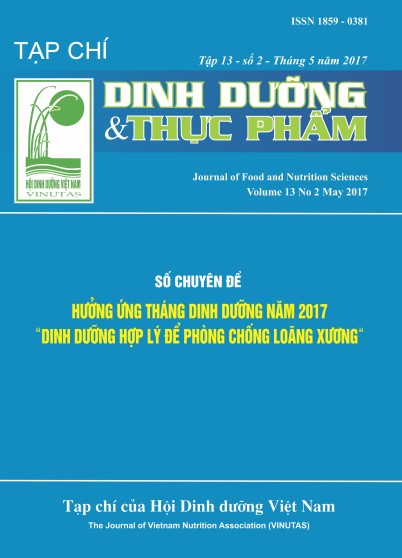SITUATION OF METABOLIC SYNDROME STATUS AND RELATED FACTORS AMONG STAFFS OF HANOI MEDICAL UNIVERSITY
Main Article Content
Abstract
The study aimed to describe the prevalence of metabolic syndrome and related factors of staffs working at Hanoi Medical University in 2014. A cross sectional survey was done in 511 staffs of Hanoi Medical University, Metabolic syndrome was identified using standards NCEPATP III, with an adjustment for belly fat assessment criteria of Asian. Results: the prevalence of Metabolic syndrome of the subjects was 12.5% (22.6% in males and 6.8% in females, with OR = 4.0; p < 0.05) and it increased by age. The most common signs were reduced HDL-C and increased triglyceride (39.3% and 31.7%, respectively). The risk of having metabolic syndrome among those with BMI ≥ 23 kg/m2 was 7.6 times higher than those with BMI < 23 kg/m2 (p < 0.05). Those having high blood lipid and other chronic diseases of liver, kidney and gallbladder stones… had a higher rate of metabolic syndrome than those without (p < 0.05). Conclusion: Metabolic syndrome occurs together with its dangerous complications, which are the threat for health and longevity of people.
Keywords
Metabolic syndrome, risk factors
Article Details
References
2. Azizi F, Salehi P, Etemadi, Zahedi – Asl S (2003). Prevelence of metabolic syndrome in an urban population: Tehran Lipid and Glucose study. Diabetes Research and Clinical Practice 61(1), tr. 29-37.
3. Heng KS, Hejar AR, Rushdan AZ and Loh SP (2013). Prevalence of Metabolic Syndrome Among Staff in a Malaysian Public University Based on Harmonised, International Diabetes Federation and National Cholesterol Education Program Definitions. Mal J Nutr 19(1), tr 77-86.
4. Ramachandran A, Snehalatha C, Satyavani K et al (2003). Metabolic syndrome in urban Asia Indian adults – a population study using modified ATP III criteria. Diabetes Research and Clinical Practice 60 (3): 199 - 204.
5. Trần Văn Huy, Trương Tấn Minh (2005). Nghiên cứu hội chứng chuyển hóa ở người lớn, Khánh hòa, Việt Nam. Những tiêu chuẩn nào phù hợp với người Việt Nam Châu Á. Tạp chí tim mạch học Việt Nam, (40), tr. 9 – 22.
6. Nguyễn Viết Quỳnh Thư, Lâm Vĩnh Niên, Trang Mộng Hải Yến và cộng sự (2008). Đánh giá Hội chứng chuyển hóa ở nhân viên ngành Y tế thành phố Hồ Chí Minh. Tạp chí Y học thực hành, số 2 (597+597): 54-55.
7. Võ Thị Dễ, Lê Thanh Liêm (2012). Tần suất và đặc điểm hội chứng chuyển hóa trong cộng đồng tỉnh Long An năm 2010. Tạp chí YHTH(856)-số1/2013, 13 –16.
8. Thomas GN, Ho SY, Janus ED et al (2005). The US National Cholesterol Education Programme Adult Treatment Panel III (NCEP ATP III) prevelence of the metabolic syndrom in a Chinese population. Diabetes Research and Clinical Practice, 67: 251 - 257.
9. Nguyễn Quốc Việt, Tạ Văn Bình và CS (2012). Nghiên cứu Hội chứng chuyển hóa tại một số khu vực nội thành Hà Nội (theo tiêu chuẩn IDF – 2005). Tạp chí Y học thực hành (825), số 6, tr 129 – 132.
10.Cao Đình Hưng, Hồ Thượng Dũng (2011). Nghiên cứu một số đặc điểm của hội chứng chuyển hóa trên bệnh nhân mắc bệnh mạch vành mạn. Tạp chí Y Học TP. Hồ Chí Minh, tập 15, phụ bản số 1


